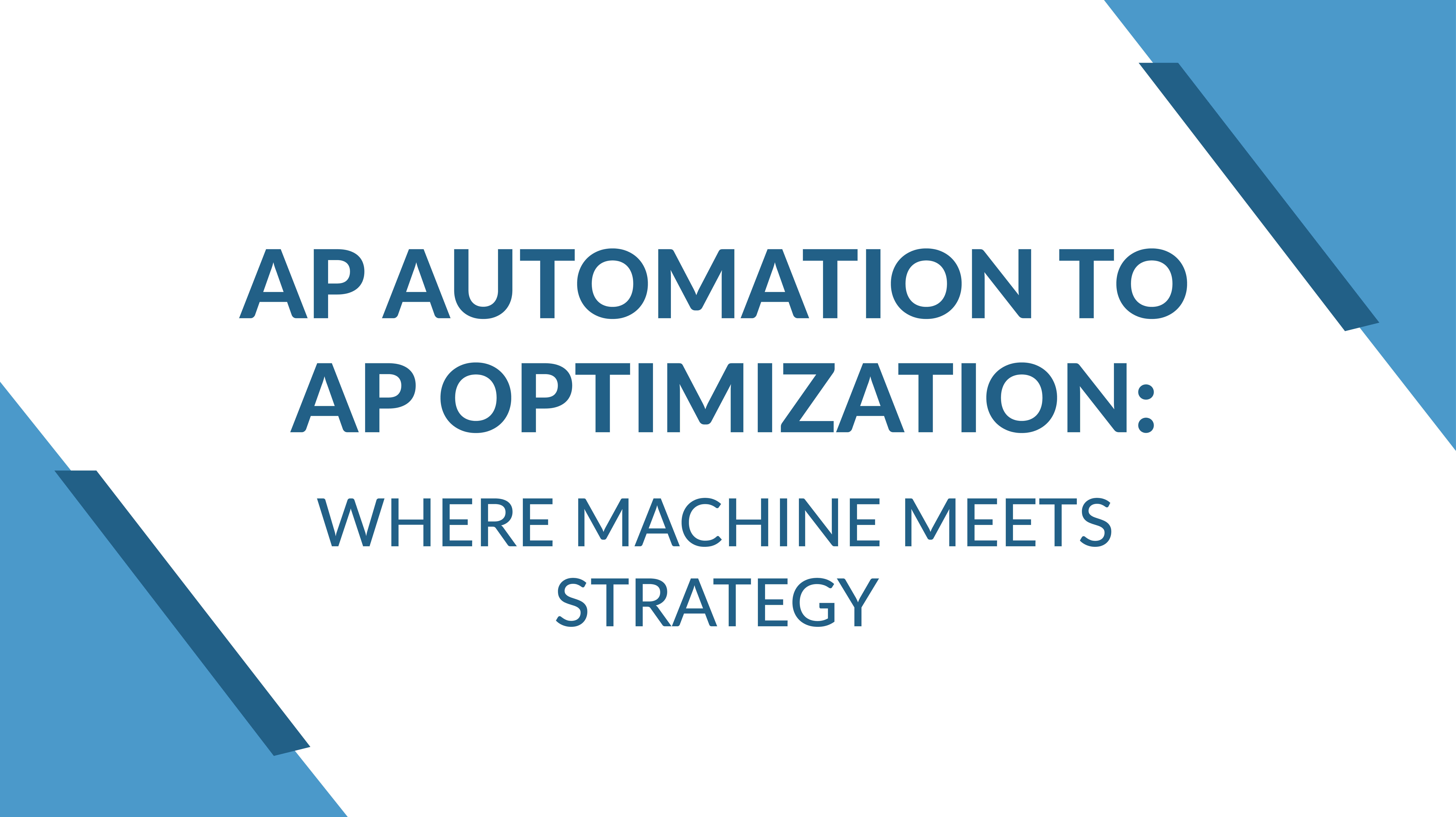Automated Accounts Receivable Programs: Cutting DSO by 30% in Six Months
In today’s economy, speed to cash is as important as speed to market. Companies that let receivables linger for 60, 75, or even 90 days are putting...
5 min read
February 27 2024
by
![]() Chris Cosgrove
Chris Cosgrove

AP automation is revolutionizing the world of accounts payable, but AP optimization involves using automation as a tool for wider transformation and growth initiatives.
In business today, most organizations are under pressure to manage more complex and time-consuming tasks with fewer resources. And for accounts payable departments, this means finding ways to reduce invoice and payment processing times while also managing cash flow and working capital in order to drive growth.
In a MineralTree’s 2023 State of AP Report, “AP automation was ranked as the top back-office digitization priority (#1) – ahead of AR, expense management, close management, forecasting, and treasury management.
This blog will highlight the impact of AP automation and how it’s improving efficiency and accuracy across accounts payable departments. Additionally, it will highlight how AP automation affects high-value, non-automated tasks and how financial leaders are finding ways to optimize work roles as a result.
One of the most obvious benefits AP automation has brought to accounts payable teams in recent years is a streamlined procurement-to-pay (P2P) cycle—which begins at invoice receipt and continues through account reconciliation and document archival. Overall, the time and dollars saved with this technology has been enough to improve staffing quality, increase processing volumes, and even scale business upward.
Here’s how it works…
Invoice Receipt. All types of invoices (including paper, PDF, fax, email and more) are digitized and aggregated onto a single, secure automation platform. Optical Character Recognition (OCR) technology then extracts vital information from the documents seamlessly, reducing or eliminating manual data entry.
2-Way and 3-Way Matching. Invoices are automatically matched with POs and/or delivery receipts and data is saved on the automation platform.
Invoice Approval. After documents are matched, each invoice is automatically routed to its approver based on pre-set business rules. Unmatched invoices caused by discrepancies, duplication, and other errors are flagged for review.
Exceptions Management. Flagged invoices and POs are automatically forwarded to reviewers based on pre-set business rules and then researched, expedited, and adjusted as necessary depending on the nuances of each scenario.
Posting and Payment: Approved invoices get sent to the ERP or accounting platform and post automatically, without the need to re-key data. Payments are then processed according to pre-set business rules and each vendor’s preferred payment method.
Archival. All invoice-related documents are stored securely online; users can retrieve documents easily and filter information by date, supplier, invoice number, and more.
Aside of the obvious time savings, here are some additional benefits of AP automation in accounts payable:
Eighty-six percent of CFOssurveyed by Gartner cited digitization of finance processes as the key to their company’s success.
If you’ve researched the topic enough, you’ll notice there’s plenty of information out there about how AP automation reduces manual tasks for accounts payable staff and saves a department time and money on processing.
What you may not hear as much about is how automation affects the critical tasks that require hands-on attention. This is where optimization comes in—where financial executives can take advantage of combined processing efficiencies to move the company’s bottom line. Here’s what optimization does:
One of the first things to consider in regard to optimization is the increased visibility achieved when manual AP processes are eliminated. To put this in perspective, it’s important to note that historically there’s been difficulty accessing invoice transaction statuses in accounts payable due to extensive paper-based processes; this makes payment inquiries, accruals, and audits more difficult to complete.
But with automation, invoice processing is made available on one, centralized platform and its relative data is stored in a cloud-based environment for anytime access. These capabilities give financial leaders opportunities to use data more efficiently and make business decisions based on real-time information.
Better cash flow management is another positive result of automation, and with automation tools providing real-time insights on key metrics affecting a business, finance teams are usually able to more easily understand their company’s cash requirements and prioritize the factors that affect cash flow.
To this end, when adequate cash reserves are maintained, credit can be leveraged to help fund growth and other capital investments. Not only that, but a business can use credit to pay vendors early and secure valuable cash rebates—a tactic that helps optimize cash flow while also putting Days Payable Outstanding (DPO) into acceptable ranges.
A common concern for most financial leaders is the quality of the relationships between business and vendor, so strengthening vendor relationships is an important task made easier with the help of AP automation.
Because of automation, an AP team is able to quickly look up vendor inquiries, review open invoices, check on approvals, pay vendors, and more. The resulting availability of information and speed of payment will, over time, promote better working relationships with vendors and present more opportunities for business growth.
Spend management involves bringing the processes of procurement, outsourcing, P2P, and supply chain management into a business’s single control unit. Once accounts payable processes are automated, the real-time data available provides staff useful information on spending patterns and budget status.
The reason automation becomes so important here is the fact that the purchase and delivery processes in accounts payable are a direct result of spend management decisions. Conversely, data gathered from accounts payable is used to make future decisions on spend. In the end, understanding this interconnectedness helps financial leaders make better decisions that benefit both areas of the business.
Fraud has consistently been a concern for accounts payable teams, especially with data moving to online environments in recent years and siloed systems becoming more burdened by security threats and breaches.
Fortunately, AP automation has improved the invoice process significantly with its advanced validation features which ensure 2-way and 3-way matching, accurate receipt of goods or services, price verification, and vendor validation. Combined, these actions help prevent overbilling, double billing, and duplicate invoices.
Above all, with automation, financial leaders gain full visibility of a product or service’s payment trail and can be notified of irregularities or anomalies in data and then subsequently investigate any problems.
When invoice data is captured accurately, dated, and timestamped, it’s much easier for businesses to comply with accounting requirements. But to manage a business’s finances on a wider scale, leaders must also make sure their teams follow standards, laws, and regulations related to payments.
Automation assists in compliance by flagging any nonconforming activities as they arise. It also helps teams generate accurate reports and track obligations and potential risks to their accounts.
Goldman Sachs estimated that AP automation can drive 70-80% time savings for small and medium-sized businesses (SMBs).
With the rapid growth of AI and automation, it’s become a common concern that AP staff will lose jobs due to automation. This is often not the case, however, since automation plays a role in triggering growth and expansion in many organizations. Some businesses have also found they’ve been able to manage additional workload with the same number of employees.
At the core level of AP departments, processors are finding themselves freed up from manual data work and able to expand their competencies in data analysis, compliance, payroll, expense reimbursement, and more. These new skills then bring higher job satisfaction for employees and provide opportunities to advance into larger departmental roles over time.
Controllers have historically faced battles between managing day-to-day business tasks and focusing on the fiscal health of their businesses, but fortunately, automation is shifting this competition away. After automating AP, controllers have been able to realize significant time savings which results in the ability to focus on strategic activities like managing compliance, keeping up with regulation changes, and fostering better vendor relationships.
At the CFO level, automation has given financial leaders the ability to optimize working capital and promote growth while gaining better control over corporate spend. And with real-time access to data, CFOs can measure KPIs faster, analyze reports more easily, and focus on improving ROI.
Ninety-eight percent of businesses in a PYMNTS and Roundtable study said that AP automation was speeding up their payables processing and fueling corporate growth.
Getting off the ground with AP automation starts with finding an end-to-end solution able to streamline and digitize your invoice and payment processing tasks.
CloudX has been automating accounts payable departments for over a decade and has helped a variety of businesses grow and scale up successfully.
For a complimentary demo, please reach out to CloudX and fill out the online form here. Or to learn more about what automation can do for your AP department, pleasecontact CloudX here.

In today’s economy, speed to cash is as important as speed to market. Companies that let receivables linger for 60, 75, or even 90 days are putting...

Managing operational costs today often means balancing operational costs against tight margins, making it essential to join a group purchasing...